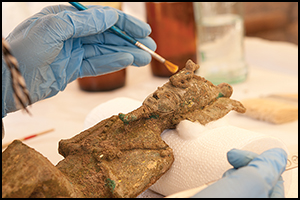Published online by Cambridge University Press: 20 September 2017

The relationship of statues to the deities they represent is reflected in the special treatments they were often accorded during and after their primary use and display. In 2014 an unusual favissa—an intentionally hidden cache of religious objects—was discovered in the temple of Ptah at Karnak in Egypt. Such caches are generally poorly documented and difficult to date. The favissa contained numerous fragmentary statuettes and figurines, including 14 representing Osiris, carefully arranged around a larger central statue of Ptah. By comparing this cache with evidence from other Egyptian favissae, a hypothesis is proposed to explain the creation of such caches: the Osirian burial of an artefact, in this case the deposition of the ‘deceased’ statue of the god Ptah and its assimilation with Osiris, the god of rebirth.